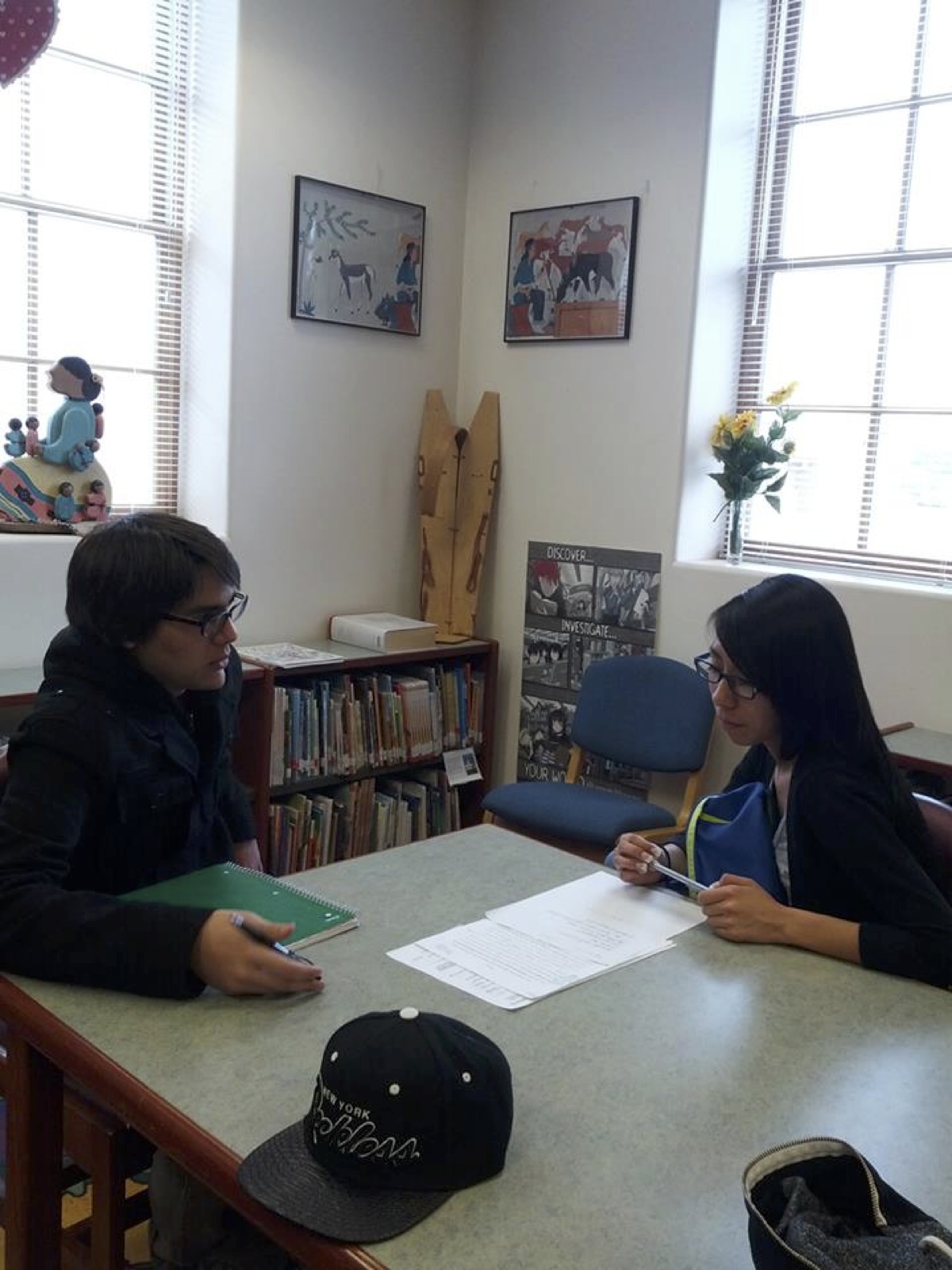Student-Centered at Santa Fe Indian School: Writing Center Anchors Collaboration
0May 14, 2014 by Tom McKenna
 by Susan Miera and Jennifer Guerin
by Susan Miera and Jennifer Guerin
“My dream is that every classroom can become a writing center in its own right.” Those words have played and replayed themselves in my head a million times over the past year. In September 2012, the Santa Fe Indian School, Write to Change, and Bread Loaf School of English formed a partnership focusing on writing across the curriculum, and a systemic shift to a viable student-led high school writing center began to emerge from the plan.
After forty years in the classroom, I retired in June 2013. People tease me because I’m not totally gone from a school setting. To be honest, the minute I formally retired, I missed my interaction with high school students and missed even more the teaching of writing. Yet, I also soon learned to love my free time and the opportunities to explore different skills. I began my search for the best of both worlds. Jennifer Guerin, my assistant and long-time Santa Fe Indian School 12th grade ELA teacher and member of BLTN, and I began a journey to understanding that has molded our present-day thinking.
The Santa Fe Indian School Writing Center grew out of a need to have students become responsible for their own writing, but over the past year we’ve also had to become responsible for our own teaching. I spent most of my career in the classroom commenting on the weaknesses and strengths of student writing and trying to get students to revise to “perfection.” Sometimes I negatively enabled them in a myriad of ways that made me feel that I was the required element in their writing process. This year has been a journey to awareness both for me and for Jennifer as much as it has been for the student mentors and the clients who have come into the center for help.
People who knew me in my previous teaching life know I was always a little impulsive, always in a bit of a hurry. Bells and curriculum guided my daily life, and I was often chided about the fact that I had no personal life between August and June. Minus the bells and curriculum, I realized that I personally did not need those elements to define me as a writer and a thinker.
Jennifer Guerin reminds us that writing is a process learned over a lifetime when she writes, “‘How can I know what I think until I see what I say?’ asked E.M. Forster. Indeed, how do we come to understand our own thoughts, clarify our ideas, or work our way towards an answer to a prompt unless we have rehearsed our words over and over again—in our minds, with our pens, and through the keyboard? As teachers of writing we often take for granted the steps of the writing process; we internalize the many conversations and choices inherent in the act of writing, speeding through them on our way to a final product because we have exercised those muscles repeatedly over time. And yet for student writers—both the tentative and the confident—externalizing those conversations is the first step to building writing that works.”
So what changed for us? Many teachers and administrators, I think, view student academic success, documented by good grades, as a mirror of good teaching. If a student is a good writer or if a student is challenged by writing, educators often see those “successes” and “failures” as a representation of themselves as “good” or “bad” teachers. Although I’ve always known this premise to be academically untrue, not until I was freed from the mandates of grading, from the concerns of teacher evaluations, and from meeting ever-changing standards did I truly begin to believe the untruths in this idea.
Jennifer reminds me that “watching our peer tutors build a culture of writing at SFIS over the course of the last semester has been inspiring. Observing conversations between peer mentors and student writers has reminded me that writing is, in fact, as much about talking as it is about words on the page. In developing the Writing Center, we hope we are developing a community of young people working together (independent of their instructors) to see what they think and to say what they mean.”
As students came into the writing center to be trained as student mentors, I struggled to shed my “teacher” identity ingrained in my psyche over the previous forty years. This was the most difficult part of the writing center learning experience for me. I wanted to dictate how students should conduct a writing session, what questions they should ask, what good writing looked like, and what other teachers expected good writing to be. Writing tutors questioned those premises, and what I soon realized and accepted will remain with me for the rest of my life.
This light bulb did not immediately go on in my head, but the light instead was more of a compact fluorescent light that reaches its apex of brightness only after it has been on for a while. The realization congealed as the fact that I became a teacher, and remained a pretty darn good one for those forty years, not for personal accolades but rather to help students find their own voices and to help them make sense of their own writing. Student mentors soon showed me that they can read difficult texts, can talk through a myriad of meanings, and can voice their opinions in succinct and understandable ways. Given the opportunity, free from grading and classroom constraints, they can ask pertinent questions. They can find relativity to themselves, and they can do this all without me to guide them through every step of the process. Student mentors can and do impart these ideas to their clients. Brightness achieved.
Jennifer shares a bright moment in her memory about a reluctant 12th grade student clarifying his thesis for a major research project with one of our senior staff last semester. For Jennifer the moment “remains, four months later, one of the highlights of my year. Using the protocol for writing center sessions that we had run through just days before—a protocol that seemed abstract and even awkward in training—our tutor made real progress with this writer in a matter of minutes! Cool and curious, honest and interested, his simple act of listening led to asking questions. Asking the right questions led to honest talk, and the honest talk between peers led to clearer writing, to a product that, quite simply, made good sense.”
With these realizations and observations, I, too, had to switch hats. I no longer had to be the teacher who solely gave instruction, but rather, I had to become a much better listener. I realized that students don’t want canned approaches to writing; they don’t even want example after example of what teachers consider good writing. What they want is to be heard and to have help with how to make their writing meaningful conversations for authentic readers. They want the freedom to express their opinions, to substantiate those opinions with researched facts, and to evoke reactions from their readers that will help to continue the conversation.
I’m not so sure I didn’t know these ideas beforehand, but I was so constrained by the elements of everyday classroom protocols that I somehow put those ideas on the back burner. The beauty of running a writing center is that I can revisit those premises with no strings attached, and students can feel free to bounce ideas off their peers and ask for support in ways that they rarely or never have the opportunity to do in a classroom filled with academic gobbledygook and time constraints.
Classroom learning is indeed as necessary today as much as it has been needed in the past, and I will always have the utmost respect for the classroom teacher who, on a daily basis, embodies the ideals of any superhero ever imagined. However, offering students the opportunities to write outside the classroom, in unrestricted ways, is also beneficial to students in many ways.
The writing center has been an enriching and invigorating experience for both Jennifer and me. Both of us have been writing more, and as Jennifer reiterates, it’s been a good experience for both of us. She comments, “I, too, have been writing more these last few months since the SFIS Writing Center opened for business. And I have been talking to people about my writing. This weekend I had coffee with my ‘writer friend.’ We read our work out loud over cups of coffee in a crowded cafe. There was something liberating about speaking the words and answering questions about my choices—something about owning those choices that increased my investment in putting the piece together just so. As I left the cafe, my mind buzzed with excitement and ideas for developing my latest essay. And I thought to myself: I’ll need to thank my tutors for that.”
Retire? Yes and no. My dream is that every classroom can become a writing center in its own right. What I’d like all classrooms to be are safe places for conversation about writing, places where students can bounce ideas off each other without the fear of grades, a place where students can talk to their peers about what ideas make sense and which ones don’t. This classroom writing center concept would be lessons in “writing to learn” that lead to final papers/presentations that are “writing to communicate.” I’d like to see students work more closely with teachers and students inside the classroom in an effort to communicate unique ideas rather than regurgitating lecture notes or teachers’ ideas. How wonderful would that be? Light bulbs keep going on in my head, and “I’ve got miles to go before I sleep.”
Visit this page to view photos and read testimonials from the Writing Center mentors themselves. View and listen to video comments below.
Category Campus News, Spring 2014 | Tags:


Leave a Reply